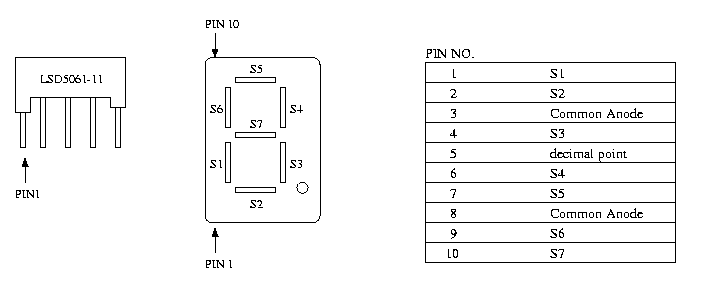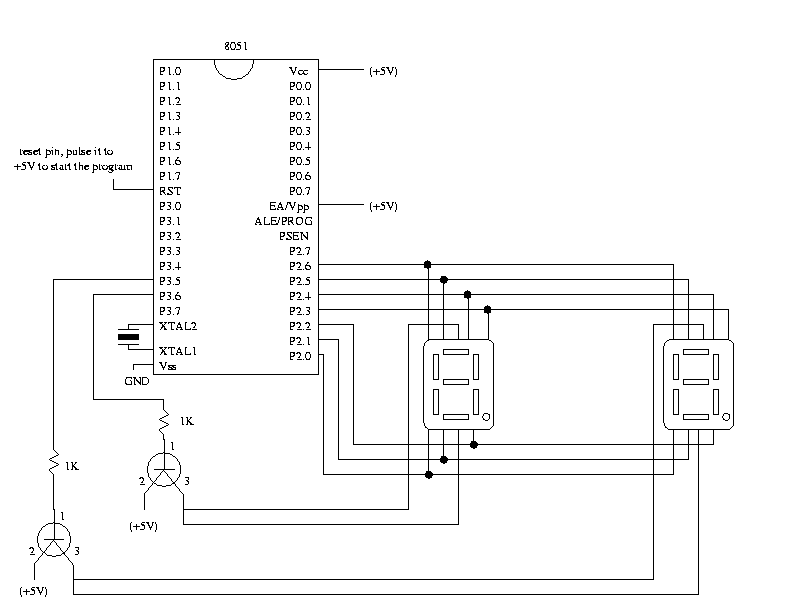
Decimal Counter and Multiplexing the Output
Introduction
The purpose of this lab is to implement a decimal counter which counts from 0 to 99. You will have to write a C program for the 80X51 micro-controller. You will then compile your C program using C51 compiler and burn it unto an 8051 stand alone chip. You will also have to do some wiring in this lab. The 8051 chip requires some connections to function properly, and the 7-segment displays need to be wired to the 8051. Schematics are provided below.
Seven Segment Display
Before you can write your C program, you have to understand how the
7-segment displays work. The 7-segment displays used in the lab
are the LSD5061-11 display. Each of the segment corresponds to a
pin (see below for the pinout). In order to light up a particular segment,
it's pin must be set to 0V. Since these pins are connected to the
8051, we simply set the corresponding pin on the 8051 to '0'. To
turn a segment off, the pin must be set to 5V. This is done by setting
the corresponding pin on the 8051 to "1".
Instead of going through each of the seven pins and setting them to
'1' or '0' each time we want to display a number, we will use a
lookup table unsigned char LookupTable[11] = { }. The
location of the entry in the table corresponds to the correct pin
settings to display that number. Simply, LookupTable[0] returns the
correct pin settings to display a "0" on the 7-segment display.
Now we have to figure out the correct entries into the table. We
know that in order to display a "0" on the 7-segment display we
need to turn on segments s1, s2, s3, s4, s5, and s6. To turn a
segment on, we set the corresponding pin to "0". Segment s7
will need to be turned off. To turn off this segment we set the
corresponding pin to "1". Therefore, the pins will need to be
assigned the following values:
P2^0 = 0;
P2^1 = 0;
P2^2 = 0;
P2^3 = 0;
P2^4 = 0;
P2^5 = 0;
P2^6 = 0;
P2^7 = 1;
P2^8 = 1; //don't care what this value is since it is not used
We set it to 1 because the 8051 pins are by default 1
The bit pattern desired is 1100 0000 (remeber that pin 8 is the
highest bit). We then convert the values into hexadecimal 1100 -> C and
0000 -> 0. We fill in the table with this value 0xC0. The "0x" is
needed before the actual value to indicate to the compiler that it
is a hexadecimal value. Now when we call LookupTable[0] it will
return the proper configuration to display a "0" on the 7-segment
display. You will need to fill in the rest of the values (1-9).
LookupTable[10] will indicate an error has occured, at this
location segment s7 will be on, the remaining segments will
be off. (If you want, you can also look at the 7-segment display
datasheet.)

Multiplexing the Output
We have two 7-segment displays connected to the same port on the
8051. Because the circuit is connected in this way we have to
multiplex the output. This means that we will turn on the
7-segment display corresponding to the one's place, turn off the
ten's place 7-segment display, and configure the output port to
display the one's value. Then we will turn on the 7-segment display
corresponding to the tens place, turn off the one's place 7-segment
display, and configure the output port to display the ten's place. If
we do this fast enough, we will not be able to notice that one of
the 7-segment displays is off and one of the 7-segment displays is
on. It will look as if both segments are being handled seperately.
The next question is how we are supposed to turn the 7-segment
displays off and on. You will notice that there are two pins on
each of the the 7-segment displays which correspond to common
anode. If we set these pins to +5V the 7-segment display is
on. If we set these pins to 0V the 7-segment display if off. The
two common anode pins corresponding to the ten's place display are
connected to P3^6. If we want to turn the ten's place display on
we simply set P3^6 to 1. If we want to turn the ten's place
display off we set P3^6 to 0. The same applies for the one's place
display connected to P3^5. To turn it on we set P3^5 to 1 and to
turn it off we set P3^5 to 0. The problem we then encounter is
that the 8051 cannot drive components. Althougth we
set a particular pin to 1, the 8051 does not provide the +5V needed
by the 7-segment display. To remedy this we must use transistors.
The schematic below shows how to connect these.
Assignment
In this lab :
Apparatus Required
Schematic

Program
/* main.c */
/* decimal counter with multiplexed output */
#pragma SMALL DB
#include
Procedure
Hardware
Software
Burning A Chip - Programmer: MP-51
c51 count.c
bl51 count.obj to count.omf
oh51 count.omf
copy count.hex A:\count.hex
Testing Your Program